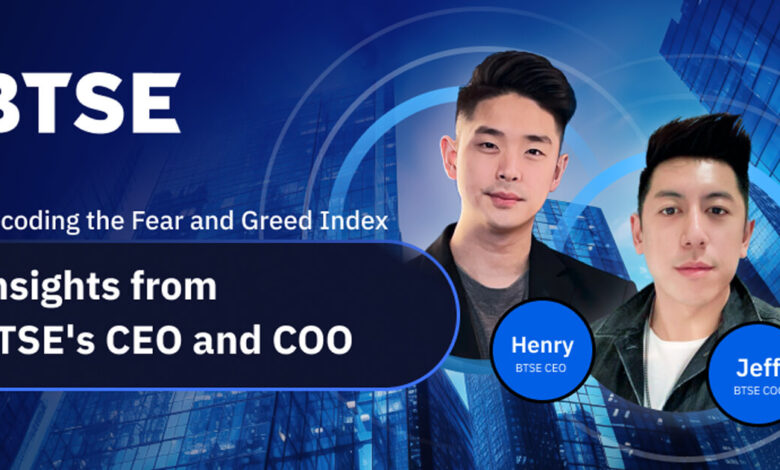Insights from BTSE’s CEO and COO

DOGE. PEPE. AI altcoins. Every now and then a memecoin explodes into the stratosphere, and we’re all left wondering how exactly it all happens. We sat down with the top execs at crypto exchange BTSE to get to the bottom of it. CEO Henry Liu and COO Jeff Mei gave us their honest perspectives on the hype and hope behind the fear and greed that drives markets, whether that’s crypto, commodities, or plain old fiat currencies. TLDR – Henry and Jeff believe ‘retailization’ is an inevitability for the crypto industry, and share insights from BTSE’s recent FUD & FOMO report.
Interview with Henry Liu, CEO of BTSE and Jeff Mei, COO of BTSE
Q: To get us started, you’ve often said that ‘Retailization’ is here to stay. Can you dig into that, what does that mean?
Henry:
Sure. We’ve always said the retail adoption of cryptocurrencies and the wider Web3 world is an inevitability. “Retailization”, it’s this idea that everyday retail usage of crypto is growing, that Web3 is getting more mainstream. The industry has hit some pretty big pitfalls along the way – and there’s no need to name names here – but we still don’t see that ultimate destination changing at all. Maybe just the time horizon, until we see crypto actually integrated seamlessly into daily life around the world.
Jeff:
Right. Even though the doubters got louder during this crypto winter, and got a larger share of the headlines, we’ve seen that negativity completely blindsided by the FOMO rallies for PEPE and AI altcoins, etc. There will always be this sort of FUD & FOMO cycle in crypto – Fear, Uncertainty, and Doubt fuels the downswings, then Fear Of Missing Out often drives the upswings. In TradFi they call this the fear and greed index. But overall there’s an upward trajectory to adoption. And these memecoin rallies always return to remind us all that there’s still plenty of upswings to be had. We had a report out on these FUD and FOMO dynamics recently, diving into the psychology of it all.
Q: Maybe we can use the hype about PEPE as an example. How did this token get so much traction all of a sudden?
Henry:
The funds poured into the PEPE rally are very much rooted in retail trading. And much of that is fueled by online sentiment and community. Pepe itself is a frog cartoon that’s been a hugely popular internet meme for years. It’s taken on various meanings in the process across different regions. This project basically plugs into that existing fandom, and offers a fun, almost mindless way to interact with the wider fan community.
Jeff:
Yeah, we should highlight that the PEPE project website says it was launched “for the people” with “no formal team or road map” and is ” for entertainment purposes only.” Of course that’s to cover their backs, but is also a pretty accurate representation of the situation. You can see this whole hype train as a cultural and economic movement, born out of the digital age’s unique blend of technology, social media, and a collective desire to democratize finance. It’s actually fascinating.
Henry:
Right and it proves our point, that the retail adoption of crypto is an inevitability, whatever what the TradFi pundits say. The popularity around PEPE shows that retailization is here to stay, with a lot of unpredictability in the mix. And actually, the fact PEPE has listed on major centralized exchanges has been a major contributor to the surge in PEPE coin, as that gives retail investors access to the coins. We also listed it on our exchange, sort of as a ‘power to the people’ move. We want to give both institutional and retail investors access to the coins they want to trade, with pro-grade trading tools.
Q: What is your overall opinion on memecoins? Aren’t they harmful to the perception of the Web3 industry?
Henry:
We have to be clear that memecoins are a hyper-speculative and volatile class of crypto tokens. They lack practical uses compared to more established tokens like ETH (Ethereum) or SOL (Solana), where the tokens are designed to operate a wider ecosystem. Meanwhile BTC is mainly seen as a store of value or form of payment, and has a considerably longer track record, and its network is fully decentralized, which might not be the case with memecoin projects.
Jeff:
I’d add here that it has always been human nature to speculate, and actually making money is a major incentive that keeps our world running. So speculation in and of itself is not some moral issue, we just have to take the right mindset when dealing with these types of tokens. Dogecoin, at its peak, had a market capitalization of over $80 billion, making it more valuable than many established, traditional companies – that makes it a considerable economic force. But it doesn’t rely on any underlying value, as opposed to the way Apple’s stock has value because they sell products people use all day every day.
Henry:
So we have to remember this inherent volatility of memecoins can lead to investors losing a significant portion of their investment. That said, there is potential for these tokens to integrate into the DeFi ecosystem. Some memecoins have already begun this transition. For example, Shiba Inu (SHIB), another dog-themed memecoin, launched ShibaSwap, its own decentralized exchange, providing additional utility and value for its holders.
Q: Do you think this memecoin trend can last?
Henry:
It’s hard to say. Memecoins first exploded into the mainstream consciousness during 2021’s “Wall Street Bets” movement, a Reddit-fueled community movement. So in terms of the history of modern financial markets, we’re early into this trend. But as with any craze in the fast-paced world of cryptocurrencies, the future of memecoins is uncertain.
Jeff:
I think they could continue to grow in popularity and influence. So far, memecoins seem to be a key part of the crypto landscape. Fads do come and go though, and everything is speeding up in the digital age, so let’s see. At least it’ll be entertaining in the meantime.
Q: Any advice for anyone looking to invest in memecoins?
Henry:
Be careful out there. Recognize the risk of ‘pump-and-dump’ schemes. That’s where the price of a memecoin is artificially inflated, often by coordinated groups or influential individuals (whales), only to be sold off once the price is high. That leads to a sharp drop in value and significant losses for those who bought in during the price surge.
Jeff:
Emotional regulation is incredibly crucial for success in crypto trading. Understand the psychological forces of FUD and FOMO, and don’t let them guide your decisions. There are technologies like algorithmic trading systems and robo-advisors out there that could help avoid impulsive actions driven by FUD and FOMO. Again I’ll point to that FUD & FOMO report we had out recently – it’s recommended reading.
Henry:
It is. We outline some key trading practices to adopt: always be aware that you trade at your own risk. Maintain a long-term perspective. Develop a well-researched trading plan. Look into risk management techniques, and set realistic goals. And one of the bigger ones, learn to tell the difference between fact-based information and social media hype. Remember, if you’re not a professional, don’t put in more than you’re willing to lose. Though, with memecoins, even the professionals can get caught off guard.
Disclaimer: BTSE is an investor in CryptoSlate.





